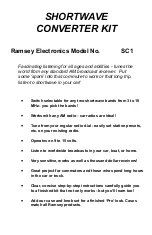
110
•
Transmission Modes
WAVECOM Decoders v6.15 W40PC, W41PC, W51PC
A more detailed description of the carrier modulation methods may be found at the end of this
chapter.
•
ACARS
•
ERMES
•
GMDSS/DSC-VHF
•
GOLAY
•
METEOSAT
•
MPT-1327
•
NOAA-GEOSAT
•
PACKET-1200
•
PACKET-9600
•
POCSAG
•
SELCAL ANALOG
•
ATIS
•
FMS-BOS
•
ZVEI-VDE
FAX Modes
Weather charts to be transmitted are fastened to a revolving drum and illuminated by a light
source. The drum is then scanned by a light sensor moving along the axis of the drum. The
voltage output from this sensor is converted into tone frequencies modulating the transmitter.
The number of revolutions per minute (RPM) is a measure of the speed of the drum on the
transmitting side. The index of cooperation (IOC) is a measure of the speed with which the
sensor moves along the axis of the drum.
A fax transmission begins with a tone of 300 or 675 Hz. The start tone has a duration of 5-10
seconds and is very well suited for exact tuning purposes. The frequency of the tone
determines the IOC value. Then 30 seconds of alternations between the frequencies
representing black and white levels are transmitted, the switching frequency being 1-4 Hz. This
sequence carries the RPM information and the receiver is now synchronized so that the picture
will start in the right position. Subsequently the transmission of the picture proper begins.
At the end of transmission the stop signal is sent. This consists of a switch-off signal of 450 Hz
having a duration of 5 seconds followed by 10 seconds of the frequency representing black
level.
•
FELDHELL
•
FM-HELL
•
PRESS-FAX
•
SSTV
•
WEATHER-FAX
Summary of Contents for W40PC
Page 1: ...WAVECOM Decoders v6 15 W40PC W41PC W51PC by WAVECOM Elektronik AG...
Page 56: ...48 General Operating Procedure WAVECOM Decoders v6 15 W40PC W41PC W51PC...
Page 238: ......
Page 242: ......
Page 246: ......















































